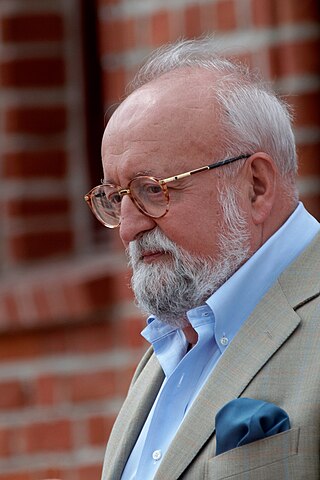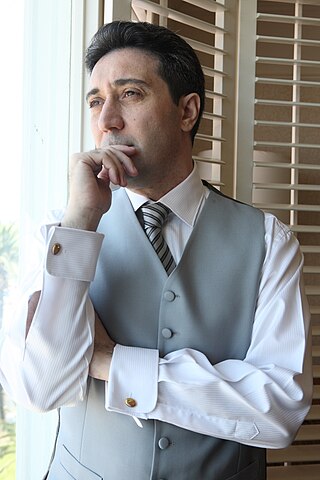Related Research Articles

Krzysztof Eugeniusz Penderecki was a Polish composer and conductor. His best-known works include Threnody to the Victims of Hiroshima, Symphony No. 3, his St Luke Passion, Polish Requiem, Anaklasis and Utrenja. His oeuvre includes four operas, eight symphonies and other orchestral pieces, a variety of instrumental concertos, choral settings of mainly religious texts, as well as chamber and instrumental works.
A concerto is, from the late Baroque era, mostly understood as an instrumental composition, written for one or more soloists accompanied by an orchestra or other ensemble. The typical three-movement structure, a slow movement preceded and followed by fast movements, became a standard from the early 18th century.

The Brandenburg Concertos by Johann Sebastian Bach are a collection of six instrumental works presented by Bach to Christian Ludwig, Margrave of Brandenburg-Schwedt, in 1721. The original French title is Six Concerts Avec plusieurs instruments, meaning "Six Concertos for several instruments". Some of the pieces feature several solo instruments in combination. They are widely regarded as some of the greatest orchestral compositions of the Baroque era.

Anne-Sophie Mutter is a German violinist. Born and raised in Rheinfelden, Baden-Württemberg, Mutter started playing the violin at age five and continued studies in Germany and Switzerland. She was supported early in her career by Herbert von Karajan and made her orchestral debut with the Berlin Philharmonic in 1977. Since Mutter gained prominence in the 1970s and 1980s, she has recorded over 50 albums, mostly with the Deutsche Grammophon label, and performed as a soloist with leading orchestras worldwide and as a recitalist. Her primary instrument is the Lord Dunn–Raven Stradivarius violin.

Pēteris Vasks is a Latvian composer.

Truls Olaf Otterbech Mørk is a Norwegian cellist.

L'estro armonico, Op. 3, is a set of 12 concertos for string instruments by Italian composer Antonio Vivaldi, first published in Amsterdam in 1711. Vivaldi's Twelve Trio Sonatas, Op. 1, and Twelve Violin Sonatas, Op. 2, only contained sonatas, thus L'estro armonico was his first collection of concertos appearing in print. It was also the first time he chose a foreign publisher, Estienne Roger, instead of an Italian. Each concerto was printed in eight parts: four violins, two violas, cello and continuo. The continuo part was printed as a figured bass for violone and harpsichord.
Wendy Warner is a cellist from Chicago, Illinois. She performs both as a soloist with major orchestras and as a chamber musician around the world.

Salvatore Di Vittorio is an Italian composer and conductor. He is the music director and Conductor of the Chamber Orchestra of New York. He has been recognized by Luigi Verdi as a "lyrical musical spirit, respectful of the ancient Italian tradition… an emerging leading interpreter of the music of Ottorino Respighi".
The International Classical Music Awards (ICMA) are music awards first awarded 6 April 2011. ICMA replace the Cannes Classical Awards formerly awarded at MIDEM. The jury consists of music critics of magazines Andante, Crescendo, Fono Forum, Gramofon, Kultura, Musica, Musik & Theater, Opera, Pizzicato, Rondo Classic, Scherzo, with radio stations MDR Kultur (Germany), Orpheus Radio 99.2FM (Russia), Radio 100,7 (Luxembourg), the International Music and Media Centre (IMZ) (Austria), website Resmusica.com (France) and radio Classic (Finland).

Anaklasis is a composition for 42 string instruments and percussion, composed in 1960 by the Polish composer Krzysztof Penderecki. It was first performed at the Donaueschingen Festival in 1960. At this first performance, it was well received by the audience who demanded an encore.
Jeajoon Ryu is a South Korean composer. His works have been by performed some of the world’s leading orchestras, such as the Royal Philharmonic Orchestra (RPO), l'Orchestre régional de Cannes-Provence-Alpes-Côte d’Azur (ORCPACA), the Helsinki Philharmonic Orchestra, and the Polish Radio Symphony Orchestra. He was the artistic director of Seoul International Music Festival from 2009-2010 and a composer of Poland Gozow Philharmonic Orchestra from 2011-2012. Artists such as Arto Noras, Michel Lethiec, Ralf Gothoni, Li-Wei Qin, Shanghai Quartet, Juyung Baek, So-Ock Kim, Johannes Moser and Ilya Gringolts have performed his works.
The Partita for Harpsichord and Orchestra, sometimes also referred to as Partita for Harpsichord, Electric Guitar, Bass Guitar, Harp, Double Bass, and Chamber Orchestra or Harpsichord Concerto, is a composition by Polish composer Krzysztof Penderecki. It was finished in 1971 and is Penderecki's only major composition for a harpsichord soloist.

The Dream of Jacob, also referred to as The Awakening of Jacob, is a composition by Polish composer Krzysztof Penderecki. It is scored for large orchestra and was finished in 1974.
The Capriccio for Violin and Orchestra is a composition by Polish composer Krzysztof Penderecki. It is one of the five caprices that he composed and one of the two that he composed for a soloist with an orchestra, together with the Capriccio for Oboe and Eleven Instruments.
Emanations, also referred to by its original German title Emanationen or by its Polish title Emanacje, is a composition for two orchestras by Polish composer Krzysztof Penderecki. Composed in 1958, it is one of his early compositions.
The Prelude for Clarinet in B-flat major, sometimes also referred to as Prelude for Solo Clarinet, is a work by Polish composer Krzysztof Penderecki. It was composed in 1987 and is one of the pieces from the series of compositions for solo instruments that Penderecki composed during the 1980s, such as Cadenza for Solo Viola (1984) and Per Slava (1986).
Three Miniatures for Clarinet and Piano is an early work by Polish composer Krzysztof Penderecki. It was finished in 1956, but was premiered four years later.

Johann Sebastian Bach wrote his fifth Brandenburg Concerto, BWV 1050.2, for harpsichord, flute and violin as soloists, and an orchestral accompaniment consisting of strings and continuo. An early version of the concerto, BWV 1050.1, originated in the late 1710s. On 24 March 1721 Bach dedicated the final form of the concerto to Margrave Christian Ludwig of Brandenburg.
References
- ↑ "Concerto per violino grande e orchestra". Nadorowy Instytut Audiowizualny. Retrieved 22 February 2014.
- ↑ Avis, Peter (2007). Penderecki: Orchestral Works. EMI Records Ltd.
- 1 2 3 4 5 "Cello Concerto No. 1". Nadorowy Instytut Audiowizualny. Retrieved 22 February 2014.
- 1 2 3 Bylander, Cindy (January 2004). Krzysztof Penderecki: A Bio-Bibliography. Westport: Greenwood Publishing Group, Inc. ISBN 0-313-25658-6.
{{cite book}}:|access-date=requires|url=(help) - 1 2 Fleming, Shirley (October 1968). "Hanover, N. H.: Webern, Krenek, & a New Violin". High Fidelity/Musical America. 18 (10).
- ↑ "Penderecki Leads BSO in Un-Haydn Program". Baltimore Sun. April 8, 1972.
- ↑ "Penderecki: Orchestral Works". Warner Classics. Warner Classics. Archived from the original on February 22, 2014. Retrieved February 8, 2014.
- ↑ "Arto Noras Penderecki: Complete Cello Concertos". Rovi Corporation. Retrieved 22 February 2014.